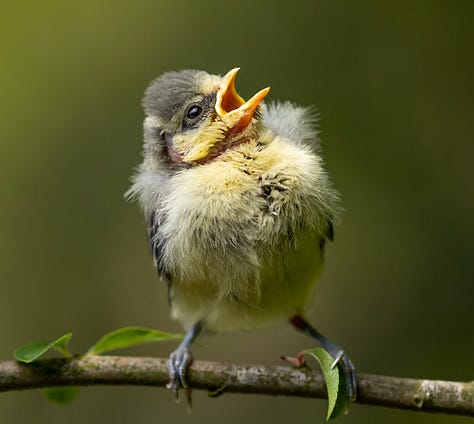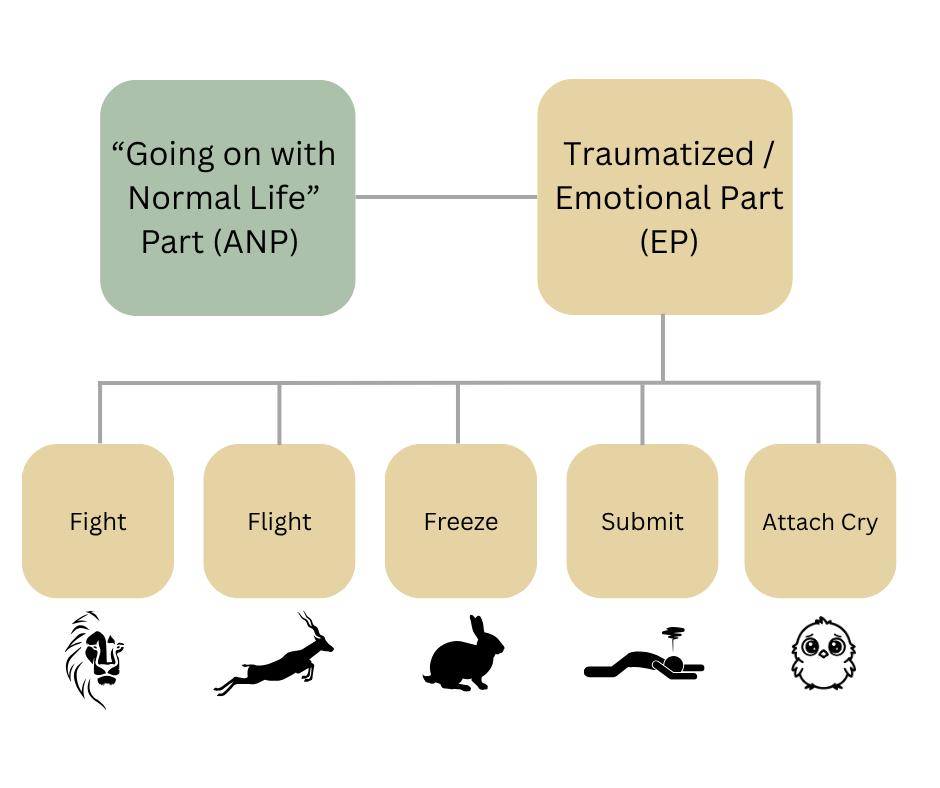Abandonment Wound Wisdom: The Science & Spirit of the Attach Response
Part 6: Completing the journey of the Fragmented Self
She speaks softly from the corner of the therapy room, with eyes that are full of need and seem too large for her face. She learned early on that survival meant making others care enough to stay.
The attach defense is both emotional and neurobiological. Our infant brains literally develop around secure connection, releasing oxytocin when bonded and stress hormones when separated.
The attach defense is charming and endearing, and speaks a totally different language than the other defenses.
Fight says "I'll hurt you before you hurt me."
Flight says "I'll leave before you can abandon me."
Freeze says "Maybe if I'm perfectly still, you won't see me."
Submit says "I'll disappear so you can't hurt me."
Attach says: "Please don't go. Please see how much I need you. Please love me enough to stay."
These five responses represent how our nervous system adapts to navigate threat. They are embodied intelligence, each with its own neurobiological signature, muscle memory, and relational imprint.
While we've explored each response individually, they exist as an interconnected system of protection that helped you survive. Now we turn to the final piece of this puzzle: the attach response.
Attach is where the abandonment wound lives, where the youngest parts of us still cry out for nourishment they never received.
Self inquiry: Have you felt the ache of aloneness, the desperation for connection? Have you ever felt like you were performing for love rather than simply receiving it?
If so, read on…
The Language of Attachment
Consider infants and baby animals, adorable with those big, sweet eyes that capture our hearts and make us willing to sacrifice everything to care for them. Their vulnerability speaks to something primal and protective in us.






Attach recruits protectors. It's a defense against the ultimate threat for a newborn nervous system: abandonment.
Though we are discussing it last in the series, Attach is the first defense to come online. It carries a wordless, bone-deep knowing that without connection, without someone to provide care and protection, survival is not possible.
The Baby Bird Phenomenon
Picture a baby bird that has fallen from its nest, mouth open wide, calling desperately for its mother. Everything about it is designed to evoke care: the large eyes, the helpless posture, the plaintive cry that tugs at something instinctual in the mammalian brain.
This is attachment biology at work.
If you've ever wondered if you were too much, too needy, too hungry for love, I see you.
Attach presents a quality of sweet innocence that can be both genuine and strategic. This part learned that being young, vulnerable, and unthreatening was the best way to secure care. It discovered that innocence could be armor, armor that protects through its very softness.
Attach develops when the natural cry for connection from the youngling is met with inconsistency, rejection, or even punishment.
But the strategy designed to secure care becomes a source of deep wounding if that care is absent.
This can create challenging dynamics in adult relationships. Attach might unconsciously lean into helplessness or vulnerability to evoke care from others. It might present problems in ways that invite rescue, or share struggles in ways that pull for someone else to fix. It can even manifest as illness to elicit the care that was missing so long ago.
This isn't conscious manipulation, though. Attach genuinely believes that its only hope lies in being cared for by others and that independence equals abandonment.
Self inquiry: As you read this, notice: Do you feel yourself becoming smaller, younger, more vulnerable? Are you aware of wanting to be seen and cared for right now?
You don’t need to try to earn love. You are loveable just as you are.
Filling the Void
Attach can feel like it's reaching for something that needed to happen decades ago, trying to fill a void that exists outside of linear time. It carries the accumulated hunger of every moment when you needed comfort and received criticism, every time you reached for connection and met rejection.
This hunger can create patterns where Attach becomes increasingly dependent on others for validation, not because it's manipulative, but because it genuinely believes survival depends on external care.
Self inquiry: Have you ever felt your heart reaching for more - more time, more words, more proof that you matter? That reaching is your attachment system trying to heal.
Notice what's happening in your chest right now. Is there a familiar ache there? Can you place a gentle hand there and tell that part it's safe now?
Attach often dreams of being truly seen by someone who understands the pain, someone whose love could finally heal all the old wounds, for someone else to complete you.
But the truth is that no external person can fill the internal void that Attach carries.
When someone seems “needy” or “clingy,” they're not being manipulative. They're often trying to heal the abandonment wound that wasn’t their fault.
If you're recognizing yourself in these patterns, I want you to know: Your need for connection isn't pathology. Your attachment system is working exactly as it was designed to, trying to ensure your survival in the only way it knows how.
The Delicate Dance, moving from External to Internal Validation
Healing Attach requires balance. This part needs consistency and genuine care to trust it's safe to exist, but it also needs to develop its own capacity for self-nurturing, through internal validation instead of external.
This happens through relationships that offer consistency without rescue. These relationships become testing grounds for learning new patterns of connection that don't require the sacrifice of strength and autonomy.
The deepest healing of Attach happens when that very young part begins to connect with the adult self rather than constantly reaching outward.
This is the moment when the baby bird discovers it has wings.
Building this internal connection requires patience as you learn to re-parent yourself with tenderness. It means learning to speak to Attach the way a loving parent might speak to a scared child.
Healing Attach also means learning to distinguish between the kind of connection that nourishes your growth, from the kind that keeps you trapped in helplessness.
The Strength They Don't See
What Attach doesn't see in itself is the fact that their survival speaks to an incredible strength.
The baby bird that fell from its nest and continued calling for help, despite receiving no response, despite facing repeated disappointment, despite learning that its cries might be met with irritation rather than care…
That bird has remarkable resilience.
Attach carries not just abandonment wounds, but also a profound capacity for hope and refusal to give up on connection. It holds the loyalty to love even when love has been inconsistent.
Healing Attach is learning that you can be both-and:
both strong and vulnerable,
both independent and connected,
both capable of standing alone and worthy of being held.
Completing the Circle
As we reach the end of this series, we return to where we began, recognizing that these trauma responses are not pathologies but aspects of Self to understand, and ultimately integrate into our wholeness.
Each response — Fight, Flight, Freeze, Submit, and Attach — arose from body wisdom and represents the nervous system's remarkable capacity to adapt and to preserve some essential aspect of who you are when wholeness felt impossible.
The path of healing doesn't disown these parts, but builds relationships with them - moving through the pain instead of avoiding it.
When we can meet each response with curiosity and gratitude, we begin the work of internal reconciliation and de-compartmentalization.
Trauma responses were the guardians that stood watch when no one else could.
In learning to honor them, we learn to honor ourselves. In healing them, we reclaim the wholeness that was always ours.
As we complete this journey through the Fragmented Self, I want to encourage you to honor and love every part that helped you survive.
Fight protected your boundaries. Flight preserved your energy. Freeze kept you safe. Submit helped you endure. Attach kept you believing in love. When we heal these fractures within ourselves, we participate in healing the larger human story, where science and spirit, mind and body, individual and collective reunite.
Self Inquiry: Having explored all five responses, which one surprised you most? Which one felt most familiar? Which one do you want to thank for its service?
The integration of these parts is where true healing lives, helping them work together in service of your wholeness.
The circle is complete, but the journey continues.
From my heart to yours,
PS. Thank you for taking this journey with me through the Fragmented Self. I hope you've found an appreciation for the remarkable intelligence of your own survival.
And if this series has resonated with you, please restack 🔄 this final post to help others find the wisdom in their trauma responses.
Does parts work speak to you? Join the Inner Circle for more healing resources:
Curious about your inner parts? Check out the downloadable guide:
Free, paid, liking, or lurking — I welcome and appreciate you. 🙏
Thank you for being here.
© Linnea Butler 2025









Trauma responses were the guardians that stood watch when no one else could. Your writing is helping me to understand and work with my trauma responses. To see them as tools that got me through. I love the clarity of your writing. Thank you
Linnea, your words land so deeply. In my own work (Return Through the Spiral), I hold these trauma responses as guardians too—living records of how the body kept us here.
I love how you name Attach as both survival and hope. In the Spiral lens, that hope is the life force that refused extinction—and when we honor it, it returns as presence.
“The circle is complete, but the journey continues” could be the Spiral’s own heartbeat. Thank you for this bridge between science and the sacred.